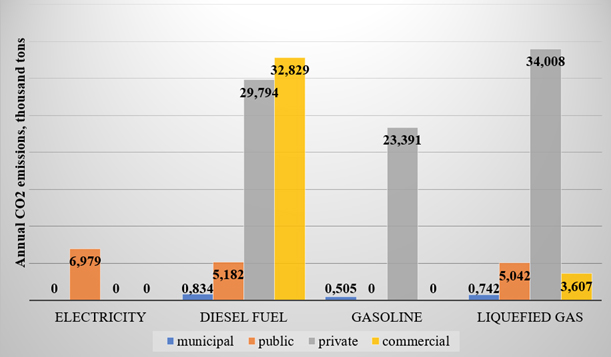Investigation of greenhouse emission inventory from transport system functioning in large and medium cities
DOI:
https://doi.org/10.15587/2706-5448.2024.298569Keywords:
transport system, greenhouse emissions, SECAP, energy efficiency, CO2, fuel type, transport categoriesAbstract
The object of the research of the article is transport system of a city. The paper reviews the necessity to assess the greenhouse emissions in the city and proposes the methods for greenhouse emissions inventory of the urban transport system. The proposed approach is aligned with guidelines for the development of Sustainable Energy and Climate Action Plan (SECAP) of Mayor Covenants of European Union (EU). The methodologies outlined in the paper allow to estimate annual greenhouse emissions from transport sector.
The SECAP defines transport sectors based on ownership and functioning as following: municipal transport fleet, public transport, and private and commercial transport. The paper proposes the methodology to estimate direct and indirect emissions in each of the described sector based on the information that is typicaly available to municipalities in Ukraine. The assessment is conducted on disaggregated level for different fuel types (diesel, petroleum, natural gas, biofuel, electricity, etc.) and separately for each fleet type (buses, trucks, passenger vehicles, specialized machinery). Total CO2 emissions are then estimated by multiplying the amount of fuel consumed by the emission factor for each fuel type and vehicle type. Information of fuel consumption is estimated based on annual milage and estimated based on available data and number of assumptions proposed in the paper. The proposed methodology for greenhouse emissions inventory for the transport sector allows to analyze available data, recommendations for data collection and a methodology for determining CO2 emissions from the operation of the transport system with sufficient accuracy of calculations.
Based on these results, it is possible to forecast changes in energy consumption and emissions in the transport sector as a result of various interventions. For example, in Zhytomyr city the results of inventory were used to develop a set of measures, which include updating the rolling stock of electric transport; increasing the energy efficiency of the power grids of the transport system, developing cycling infrastructure.
References
- Reitsen, Ye. O., Stepanchuk, O. V. (2004). Metody stvorennia i vedennia transportno-ekolohichnoho monitorynhu u mistakh Ukrainy. Mistobuduvannia ta teryt. planuv, 18, 178–186.
- Wallington, T. J., Anderson, J. E., Dolan, R. H., Winkler, S. L. (2022). Vehicle Emissions and Urban Air Quality: 60 Years of Progress. Atmosphere, 13 (5), 650. doi: https://doi.org/10.3390/atmos13050650
- Wallington, T. J., Kaiser, E. W., Farrell, J. T. (2006). Automotive fuels and internal combustion engines: a chemical perspective. Chemical Society Reviews, 35 (4), 335–347. doi: https://doi.org/10.1039/b410469m
- Use of energy explained Energy use for transportation (2022). U.S. Energy Information Agency. 2022. Available at: https://www.eia.gov/energyexplained/use-of-energy/transportation.php Last accessed: 12.01.2022
- European Environmental Agency, EEA. Air Pollutant Emissions Data Viewer (Gothenburg Protocol, LRTAP Convention 1990–2019). Available at: https://www.eea.europa.eu/data-and-maps/dashboards/air-pollutant-emissions-data-viewer-4 Last accessed: 19.08.2021
- Environmental Protection Agency. The 2021 EPA Automotive Trends Report, EPA-420-R-21-023. Environmental Protection Agency. Washington.
- Nelson, P. F. (1981). Evaporative Hydrocarbon Emissions from a Large Vehicle Population. Journal of the Air Pollution Control Association, 31 (11), 1191–1193. doi: https://doi.org/10.1080/00022470.1981.10465347
- United States: Cars and Light-Duty Trucks: Tier 3. DieselNet Emission Standards. Available at: https://dieselnet.com/standards/us/ld_t3.php Last accessed: 12.01.2022
- Bishop, G. A. (2019). Three decades of on-road mobile source emissions reductions in South Los Angeles. Journal of the Air & Waste Management Association, 69 (8), 967–976. doi: https://doi.org/10.1080/10962247.2019.1611677
- Bishop, G. A. (2021). On-Road Remote Sensing of Automobile Emissions in the Chicago Area: Fall 2020. CRC Report No. E-123, Coordinating Research Council. Available at: https://crcao.org/published-report/ Last accessed: 21.09.2021
- Stepanchuk, O. V. (2004). Metody stvorennia i vedennia transportno-ekolohichnoho monitorynhu v krupnykh i naikrupnishykh mistakh na prykladi. KNUBA.
- Reporting guidelines (2020). Covenants of Mayors for Climate and Energy, 51.
- Rukovodstvo «Kak razrabotat Plan deistvii po ustoichivomu energeticheskomu razvitiiu i klimatu v stranakh Vostochnogo Partnerstva». Available at: https://com-east.eu/ru/tekhnicheskie-i-metodologicheskie-materialy/item/14753-rukovodstvo-kak-razrabotat-plan-dejstvij-po-ustojchivomu-energeticheskomu-razvitiyu-i-klimatu-v-stranah-vostochnogo-partnerstva/
- 2006 IPCC Guidelines for National Greenhouse Gas Inventories. Volume 2 Energy. Available at: https://www.ipcc-nggip.iges.or.jp/public/2006gl/vol2.html Last accessed: 06.04.2022
- Nakaz No. 43 «Normy vytrat palyva i mastylnykh materialiv na avtomobilnomu transporti» (Mintrans vid 10.02.98). iz zminamy i dopovnenniamy, ostanni z yakykh uneseno nakazom Ministerstva infrastruktury Ukrainy vid 24 sichnia 2012 roku No. 36. Available at: https://www.buhoblik.org.ua/uchet/uchet-tovarov-i-materialov/888-normy-rasxoda-topliva.html Last accessed: 06.04.2022
- Statystychnyi zbirnyk «Chyselnist naiavnoho naselennia Ukrainy» (2019). Available at: http://www.ukrstat.gov.ua/druk/publicat/kat_u/2019/zb/06/zb_chnn2019.pdf Last accessed: 06.04.2022

Downloads
Published
How to Cite
Issue
Section
License
Copyright (c) 2024 Tetiana Tokmylenko, Olena Chernyshova, Vitalii Chyzhyk

This work is licensed under a Creative Commons Attribution 4.0 International License.
The consolidation and conditions for the transfer of copyright (identification of authorship) is carried out in the License Agreement. In particular, the authors reserve the right to the authorship of their manuscript and transfer the first publication of this work to the journal under the terms of the Creative Commons CC BY license. At the same time, they have the right to conclude on their own additional agreements concerning the non-exclusive distribution of the work in the form in which it was published by this journal, but provided that the link to the first publication of the article in this journal is preserved.







